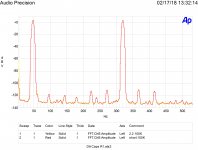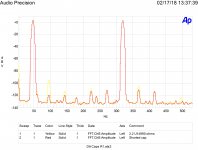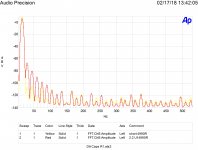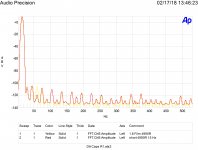George,
Attached are the runs.
First is 1 2.2 uF 100V electrolytic into a 100,000 Ohm Load compared to just a 100,000 ohm load.
Second is the same but with a 4,990 ohm load.
Third is the same capacitor into a 4,990 ohm load at 15 hertz where the impedance is close to the resistance, also compared to no capacitor.
Fourth is a 1.8 uF polypropylene capacitor under the same conditions.
I think it is very clear that where you develop voltage across any capacitor then the distortion of that device comes into play.
I also used the B inputs and outputs on my AP to be check that both chains worked the same.
Scott,
Anyone can go back in this thread and see where we were discussing filter capacitor design and SY clearly stated he did not agree with CV=q.
Now as to why I used harmonically related signals, that is the way the occur in audio signals.
As to synchronization of the FFT that is done in the runs shown.
As to my set up, the schematic has been shown.
Now we come to our usual problem, we don't communicate. It seems you follow C dv/dt = i and I follow C dv/dt + V dc/dt =i. When I have posted something using the simplified term (assuming dc/dt =0) I have mentioned dropping the other term. then there is the difference between perfect capacitors and "ideal."
There actually are very special capacitors made to maximize dc/dt!
Attached are the runs.
First is 1 2.2 uF 100V electrolytic into a 100,000 Ohm Load compared to just a 100,000 ohm load.
Second is the same but with a 4,990 ohm load.
Third is the same capacitor into a 4,990 ohm load at 15 hertz where the impedance is close to the resistance, also compared to no capacitor.
Fourth is a 1.8 uF polypropylene capacitor under the same conditions.
I think it is very clear that where you develop voltage across any capacitor then the distortion of that device comes into play.
I also used the B inputs and outputs on my AP to be check that both chains worked the same.
Scott,
Anyone can go back in this thread and see where we were discussing filter capacitor design and SY clearly stated he did not agree with CV=q.
Now as to why I used harmonically related signals, that is the way the occur in audio signals.
As to synchronization of the FFT that is done in the runs shown.
As to my set up, the schematic has been shown.
Now we come to our usual problem, we don't communicate. It seems you follow C dv/dt = i and I follow C dv/dt + V dc/dt =i. When I have posted something using the simplified term (assuming dc/dt =0) I have mentioned dropping the other term. then there is the difference between perfect capacitors and "ideal."
There actually are very special capacitors made to maximize dc/dt!
Attachments
Last edited:
No, Mark, it's that you're very much chiding everyone else about their biases and such and don't temper your own language about your own. You're also a very large presence on the forum that heavily tries to regulate/moderate discussion. So it does come down to you, as much as you may try to sincerely avoid it. We all rely on our personal experience to lens our world. I'm infinitely incredulous, out and out, we all know this (if someone didn't, newsflash!), and you definitely read my language as more rude than I convey it. Such is the nature of communication. Now, as perhaps a roundabout compliment, I am willing to argue with you simply because, while we have pretty divergent interpretations of the same data, you seem far more reasonable than many members.
I treat you as doing your work sincerely, and the best evidence you've shown is that you struggled with PMA's opamp comparison but did quite well in the end. Credit where due!
But you also did comparisons in a way that I (that's on me) struggle to see having translatable to more complex tests (like, actually listening to music rather than switching of extremely short signals) and at least diffmaker called the differences around -80 dB. So well within the realm of possibility, depending on the test. So what are we left with? Sure people may be more capable than they think, but at the same time, it's like saying we'll figure out how to travel at 99% the speed of light on present technology.
I treat you as doing your work sincerely, and the best evidence you've shown is that you struggled with PMA's opamp comparison but did quite well in the end. Credit where due!
But you also did comparisons in a way that I (that's on me) struggle to see having translatable to more complex tests (like, actually listening to music rather than switching of extremely short signals) and at least diffmaker called the differences around -80 dB. So well within the realm of possibility, depending on the test. So what are we left with? Sure people may be more capable than they think, but at the same time, it's like saying we'll figure out how to travel at 99% the speed of light on present technology.
Last edited:
I think it is very clear that where you develop voltage across any capacitor then the distortion of that device comes into play.
Did-you mean "develop DC voltage" ? I ask this in an in a humorous way, because distortion itself is a "voltage across the capacitor" ;-)
There actually are very special capacitors made to maximize dc/dt!
I wonder if they can beat the tantalums in my Tube Screamer guitar pedal?
More seriously, not clear why one would wish to define a 'perfect' capacitor as one where C is somehow voltage dependent, including the proposed rate of change of voltage?
As to synchronization of the FFT that is done in the runs shown.
Then why window them? In either case I doubt the first plots of 20Hz and 200Hz were in exact FFT bins.
Now we come to our usual problem, we don't communicate. It seems you follow C dv/dt = i and I follow C dv/dt + V dc/dt =i.
The accepted definition of an ideal capacitor has dC/dt =0, always, anything different is stated in advance. Please stop implying I don't get this and read my LA articles you might learn something. Why can't you just say you were mistaken, the DA model with nothing but ideal C's and R's has no mechanism for IM?
You asked about non-linear resistors, well I think guitar effects pedal guys love 'em the more obscure NOS ones the better. Same goes for many pathologically flawed components, the things they do are hard to duplicate by linear reasoning. They can also find use in stabilizing oscillators or in making oscillators if the non-linearity goes negative.
Last edited:
Did-you mean "develop DC voltage" ? I ask this in an in a humorous way, because distortion itself is a "voltage across the capacitor" ;-)
Any time you're using the reactance of the capacitor, e.g. a filter. In bypass where the impedance of the capacitor is extremely low, obviously there's essentially zero voltage drop across the capacitor.
That's why I mentioned that we have to pay attention to the different tests: SY's and Ed's FFT's are complementary when you get down to test conditions.
No I meant signal voltage. For some strange reason if there is no voltage drop across the capacitor then the capacitor has no effect.Did-you mean "develop DC voltage" ? I ask this in an in a humorous way, because distortion itself is a "voltage across the capacitor" ;-)
Hi Daniel,
Thank you for your considered tone. I do appreciate it. To address questions about listening that I have demonstrated with myself, at least to my own satisfaction, I know from experiences way back there have always been at least a few people who could hear much more detail than I could. At my best, maybe I was close. But, now and at the time I took PMA's test I have tinnitus and hearing loss. I don't think I can hear anything above 8kHz. What I rely on to differentiate are the frequencies I can still hear. As it turns out there are some observable differences in that frequency band.
What the foregoing means to me is that I am a poor example anymore of what a trained and practiced listener, perhaps one with some natural talent to start with, can learn to do.
Unfortunately, the present situation is that there are some people like mastering engineers, Bob Ludwig for example, have tried ABX and said it is a distracting, unusable test. They are done with it and don't care anymore. They have work to do and not time and interest to fool around here. Sadly, they were convinced to try ABX testing without the benefit of doing so in the way they are accustomed to working when they need to be highly certain. What they do is loop, and instant-switch-compare short segments. I don't know how many times this needs to be said. Please refer to the Anthony Bisset links I posted a bit earlier.
The only way out of this mess I can see is to get someone to update some ABX software to work the way it needs to with looping and one-button track compare. Then we would have to go back and convince a few mastering engineers we are not going to waste their time again with something that doesn't work, this time we know what we're doing (hopefully needless to point out I wouldn't say that unless I was sure I had fully done my homework and thoroughly tested it first). If we could do all that, it would be one big milestone, but not the end.
Once carefully demonstrating what is possible with a small group, we would need to study a more representative sample of the general population so see what the probability of certain listening ability is in untrained persons. That is something probably more applicable to cases where an untrained person makes claims arising from casual listening (at least a start in that direction, but not the end).
Thank you for your considered tone. I do appreciate it. To address questions about listening that I have demonstrated with myself, at least to my own satisfaction, I know from experiences way back there have always been at least a few people who could hear much more detail than I could. At my best, maybe I was close. But, now and at the time I took PMA's test I have tinnitus and hearing loss. I don't think I can hear anything above 8kHz. What I rely on to differentiate are the frequencies I can still hear. As it turns out there are some observable differences in that frequency band.
What the foregoing means to me is that I am a poor example anymore of what a trained and practiced listener, perhaps one with some natural talent to start with, can learn to do.
Unfortunately, the present situation is that there are some people like mastering engineers, Bob Ludwig for example, have tried ABX and said it is a distracting, unusable test. They are done with it and don't care anymore. They have work to do and not time and interest to fool around here. Sadly, they were convinced to try ABX testing without the benefit of doing so in the way they are accustomed to working when they need to be highly certain. What they do is loop, and instant-switch-compare short segments. I don't know how many times this needs to be said. Please refer to the Anthony Bisset links I posted a bit earlier.
The only way out of this mess I can see is to get someone to update some ABX software to work the way it needs to with looping and one-button track compare. Then we would have to go back and convince a few mastering engineers we are not going to waste their time again with something that doesn't work, this time we know what we're doing (hopefully needless to point out I wouldn't say that unless I was sure I had fully done my homework and thoroughly tested it first). If we could do all that, it would be one big milestone, but not the end.
Once carefully demonstrating what is possible with a small group, we would need to study a more representative sample of the general population so see what the probability of certain listening ability is in untrained persons. That is something probably more applicable to cases where an untrained person makes claims arising from casual listening (at least a start in that direction, but not the end).
Then why window them? In either case I doubt the first plots of 20Hz and 200Hz were in exact FFT bins.
The accepted definition of an ideal capacitor has dC/dt =0, always, anything different is stated in advance. Please stop implying I don't get this and read my LA articles you might learn something. Why can't you just say you were mistaken, the DA model with nothing but ideal C's and R's has no mechanism for IM?
You asked about non-linear resistors, well I think guitar effects pedal guys love 'em the more obscure NOS ones the better. Same goes for many pathologically flawed components, the things they do are hard to duplicate by linear reasoning. They can also find use in stabilizing oscillators or in making oscillators if the non-linearity goes negative.
Scott,
You are well convinced that DA does not influence the perceived sound. Many here will disagree with you based on their experience. As mentioned the only time I ignore dc/dt is in power supply calculations. In practice I have found large value film capacitors on the power rails improve the sound.
No we are not going to agree that in the real world dc/dt plays no part. When you model DA as a capacitor with out dc/dt with other RC networks that also have do dc/dt you certainly can get close. But the second issue is the limits of the added RC model. Again it is close, but would you care to demonstrate that it holds to even -140 dB. (I'll give you the friendly 20 dB discount.)
As to nonlinear resistors we both agree some folks like coloration, but some of the ones I keep around are 2,000 ohms +3300PPM for linearizing DBX2252 true rms detectors. Yes there are actual practical uses for them. But to some they sound pretty.
BTY the now obsolete AP SYS2 gives me choices as to how it will do the measurements, I can try all the options and some don't really seem to be doing what I expect. So I use the ones that give me the cleanest looking plots. Not exactly what I would like, but it is what it is.
Last edited:
You asked about non-linear resistors, well I think guitar effects pedal guys love 'em the more obscure NOS ones the better. Same goes for many pathologically flawed components, the things they do are hard to duplicate by linear reasoning. They can also find use in stabilizing oscillators or in making oscillators if the non-linearity goes negative.
It’s also an “all original” resale issue, and of course the fetish of it.
I think the carbon comp hiss is really just embedded in the guitar players psyche as to being “right”.
I also think that if you looked at the science underneath it, its due to the ways in which certain vintage parts “don’t work properly in interesting ways under interesting conditions” rather than in more predictable ways, which I think is part of the guitarists creative process. I think the moisture issues and value fluctuation with carbon comps may play a big roll.
This process probably began by non-EE minded guitarists simply screwing around. Borbely had a nice quote which I’ll butcher- don’t disregard their experience, just reconsider their explanation.
I’d like to point you all to a fascinating article / podcast regarding “working properly”.
The best selling solo piano record of all time was recorded using a badly broken and out of tune piano, partly to appease the very upset and begging young German girl who had booked the show and also partly with the intention to use the recording as a illustration of “what can go wrong” when organizers are ill equipped.
You 2.0: Embrace the Chaos | Hidden Brain : NPR
Tim Harford: How frustration can make us more creative | TED Talk
Last edited:
Lost.My money is on Mark to open page 10000
Came from the space ;-)
Hi Daniel,
Thank you for your considered tone. I do appreciate it.
...
Once carefully demonstrating what is possible with a small group, we would need to study a more representative sample of the general population so see what the probability of certain listening ability is in untrained persons. That is something probably more applicable to cases where an untrained person makes claims arising from casual listening (at least a start in that direction, but not the end).
A lot gets lost in the mix, for sure, and we all shorthand longer thoughts. Clearly I've gotten frustrated with you a few times before, and pretty sure the feeling is mutual.
I think you sell yourself short; obviously you have trained yourself quite carefully, which appears a big component of hearing test sensitivity, and the amount of energy above even 2-4 kHz drops pretty quick. We obviously don't have an idea how you "stack up" against the population. Again, we're going to interpret things differently here; I see it as further validation of the bulk range of capability, you see it as an opening for further discernment. Agree to disagree?
I have also not proffered my own test results because I think a bad data point would be a disservice, so be it far from me disrespecting those who gave it a good shot.
And, yes, testing the population that has the best chance of hearing subtleties is probably as good as it gets, which is probably musically talented youth who have been given substantial training. A good troupe of mastering engineers would be excellent for sure, but they are also invested in the idea of their capability, so that's an uphill battle. Lots can be said about test conditions and experimental criteria, which would launch us into a different great debate.
Daniel
P.S. Won't be me, as I'm off to work. Woohoo!
- Status
- Not open for further replies.
- Home
- Member Areas
- The Lounge
- John Curl's Blowtorch preamplifier part II



